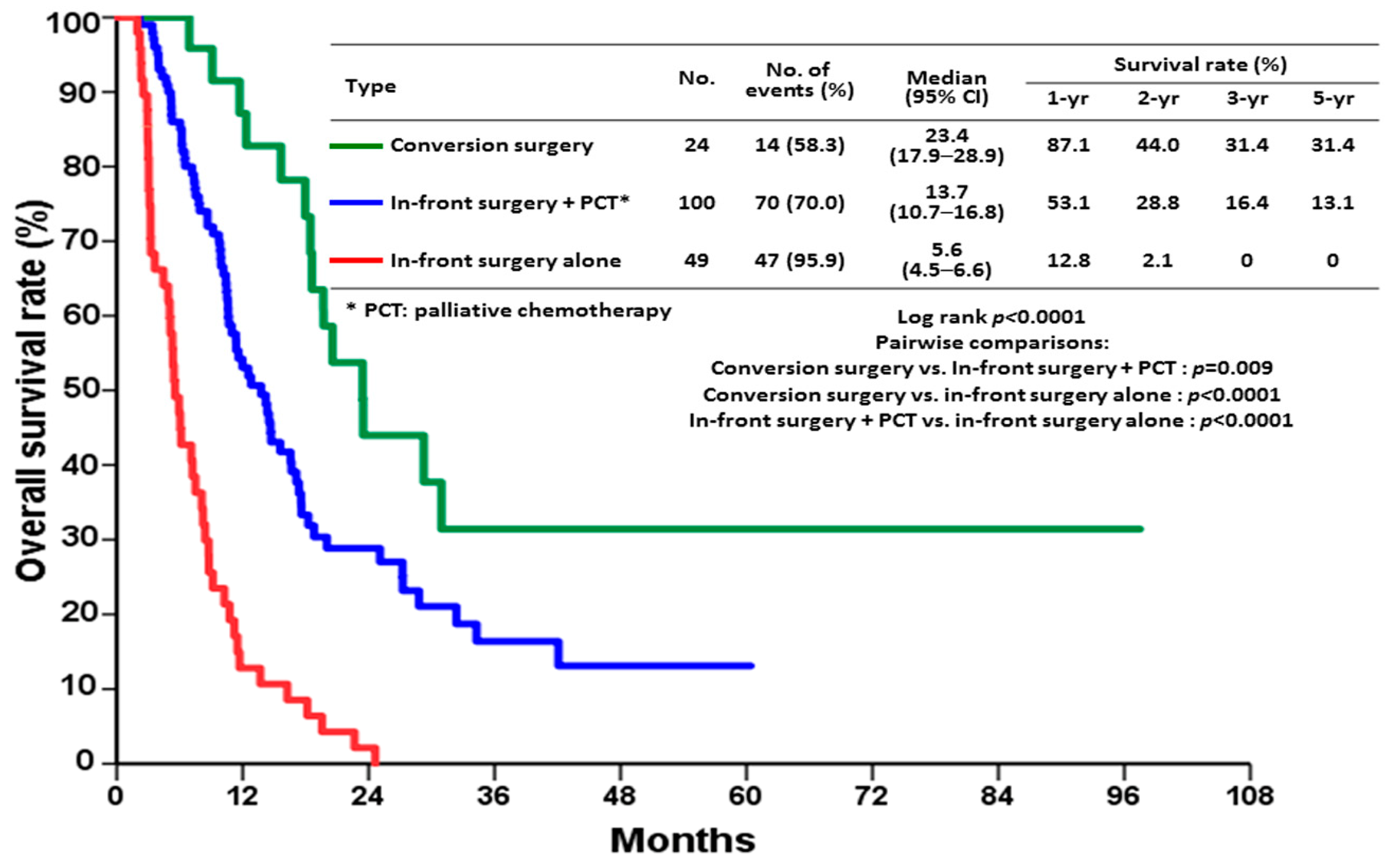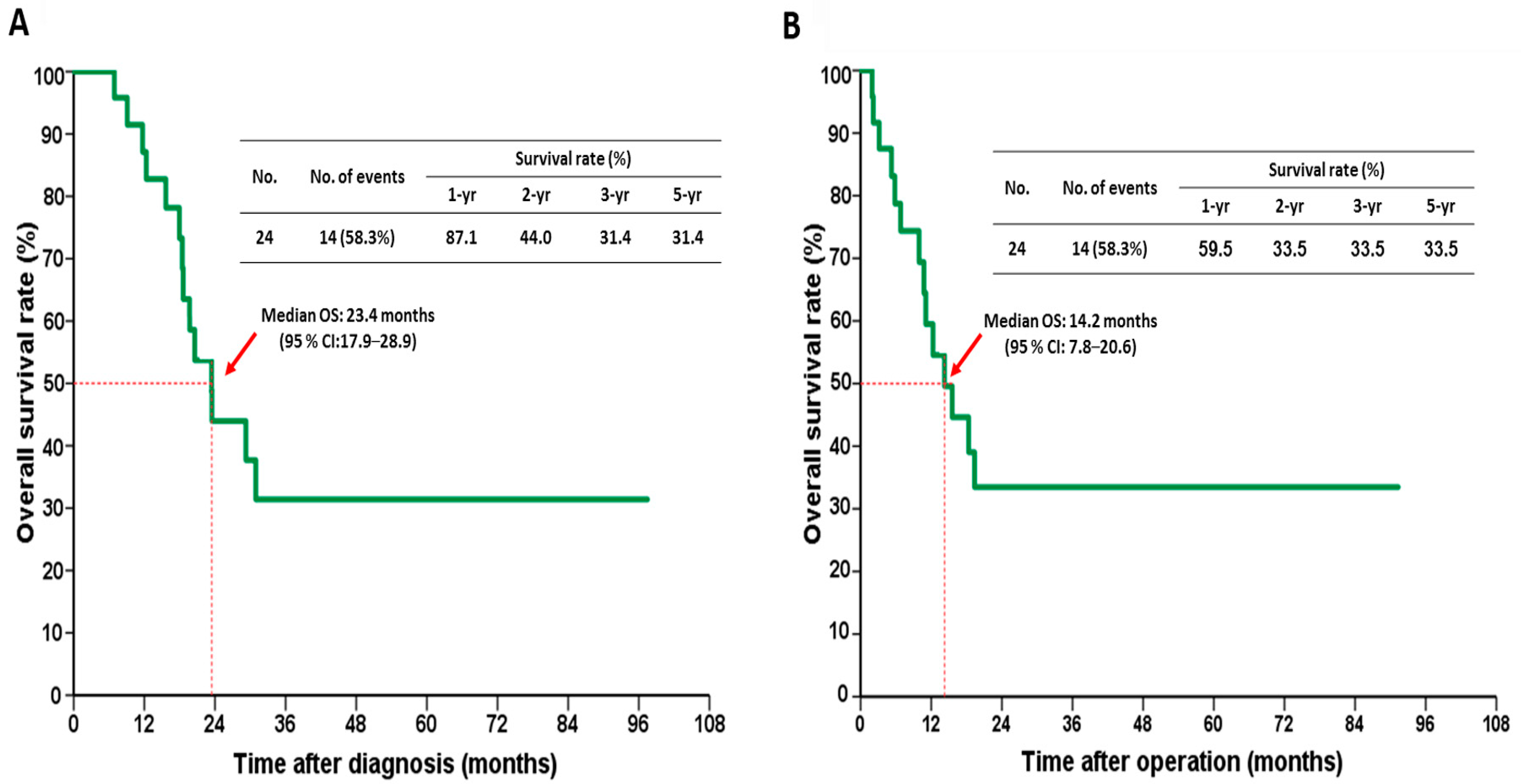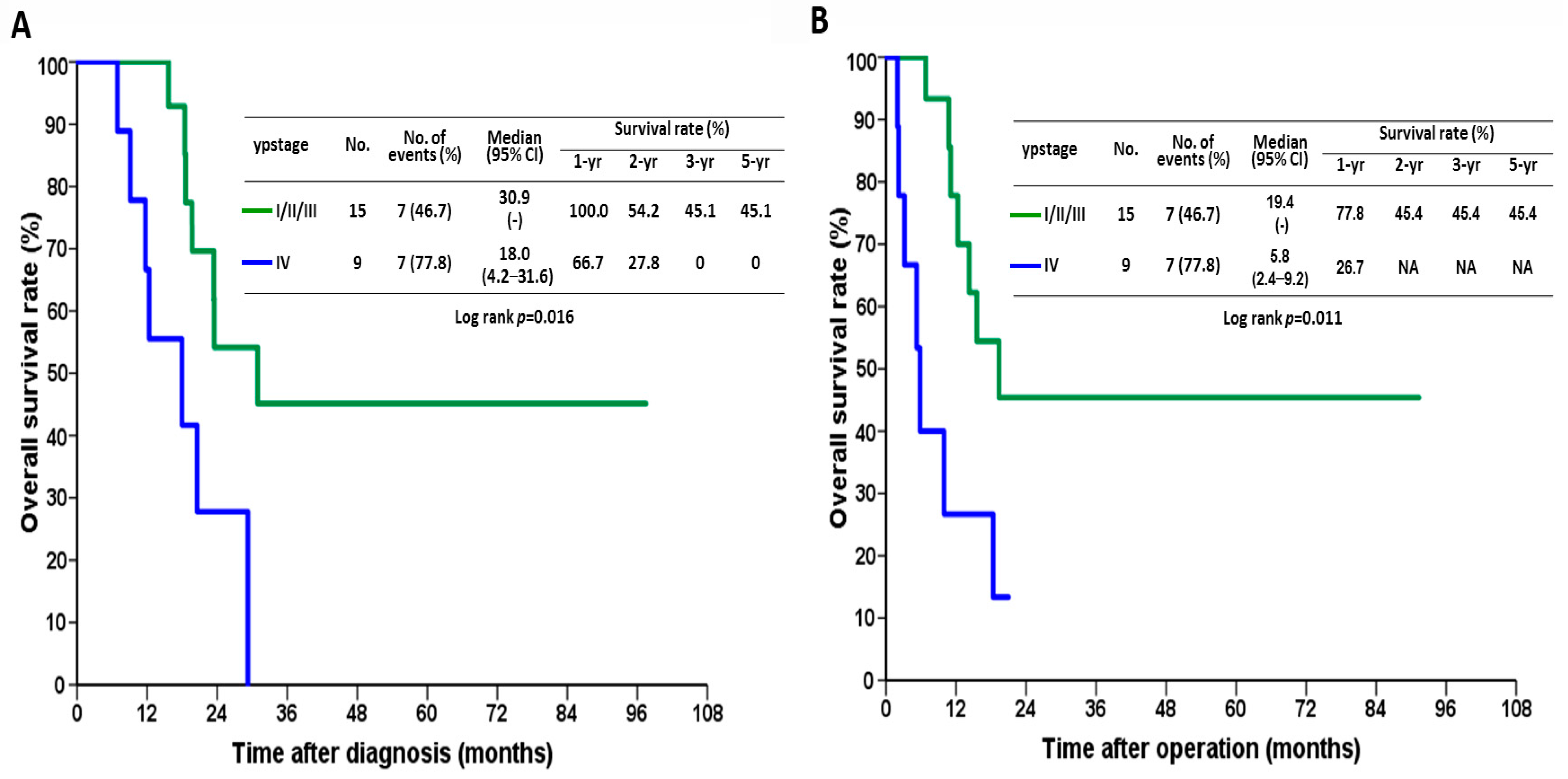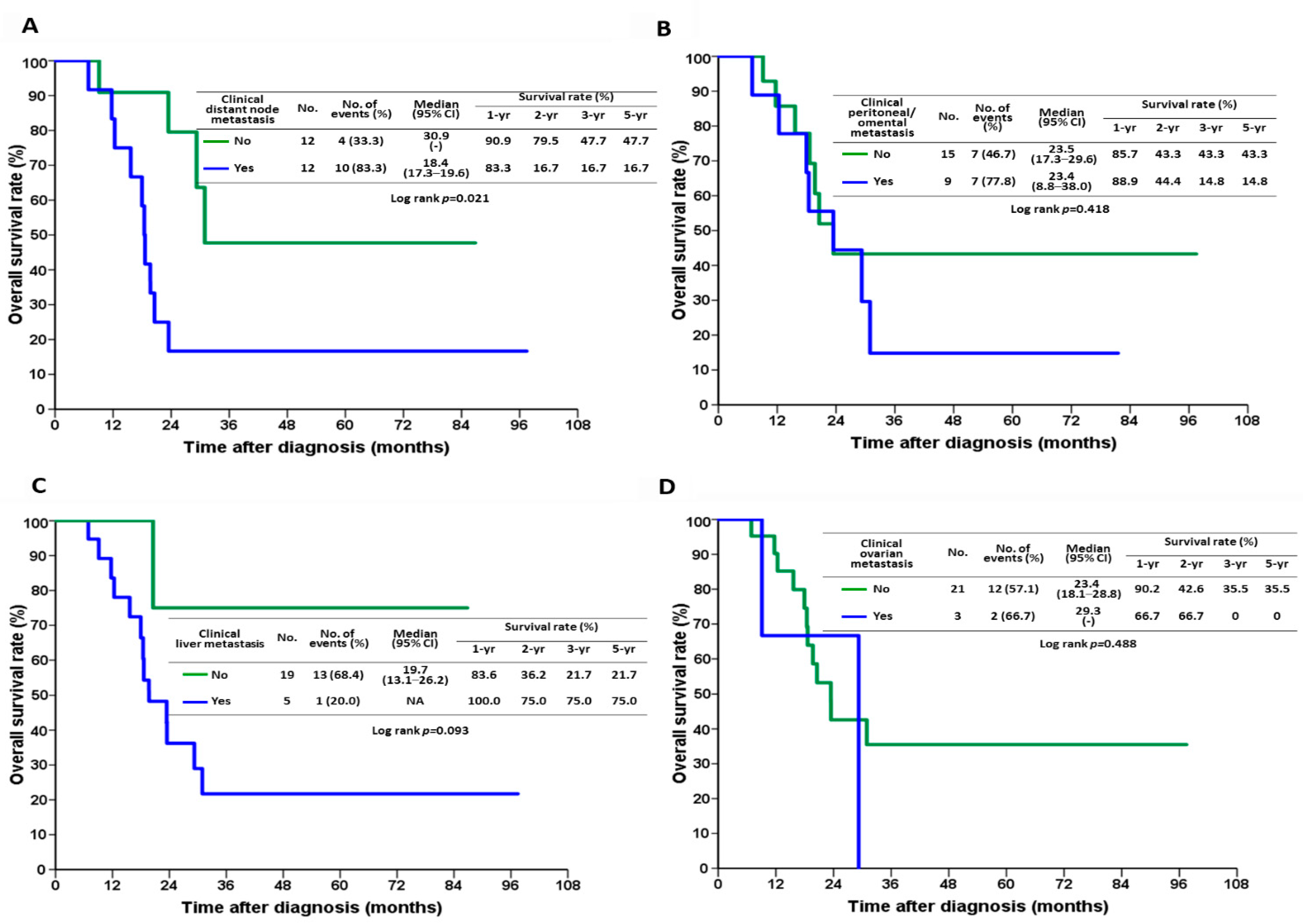Outcomes of Conversion Surgery for Metastatic Gastric Cancer Compared with In-Front Surgery Plus Palliative Chemotherapy or In-Front Surgery Alone
Abstract
:1. Introduction
2. Methods
2.1. Patients
2.2. Data Collection and Definition
2.3. Statistical Analysis
3. Results
4. Discussion
Author Contributions
Funding
Institutional Review Board Statement
Informed Consent Statement
Data Availability Statement
Acknowledgments
Conflicts of Interest
References
- Bray, F.; Ferlay, J.; Soerjomataram, I.; Siegel, R.L.; Torre, L.A.; Jemal, A. Global cancer statistics 2018: GLOBOCAN estimates of incidence and mortality worldwide for 36 cancers in 185 countries. CA Cancer J. Clin. 2018, 68, 394–424. [Google Scholar] [CrossRef] [PubMed] [Green Version]
- Lyons, K.; Le, L.C.; Pham, Y.T.; Borron, C.; Park, J.Y.; Tran, C.T.D.; Tran, T.V.; Tran, H.T.; Vu, K.T.; Do, C.D.; et al. Gastric cancer: Epidemiology, biology, and prevention: A mini review. Eur. J. Cancer Prev. 2019, 28, 397–412. [Google Scholar] [CrossRef] [PubMed]
- Bang, Y.J.; Van Cutsem, E.; Feyereislova, A.; Chung, H.C.; Shen, L.; Sawaki, A.; Lordick, F.; Ohtsu, A.; Omuro, Y.; Satoh, T.; et al. Trastuzumab in combination with chemotherapy versus chemotherapy alone for treatment of HER2-positive advanced gastric or gastro-oesophageal junction cancer (ToGA): A phase 3, open-label, randomised controlled trial. Lancet 2010, 376, 687–697. [Google Scholar] [CrossRef]
- Van Cutsem, E.; Moiseyenko, V.M.; Tjulandin, S.; Majlis, A.; Constenla, M.; Boni, C.; Rodrigues, A.; Fodor, M.; Chao, Y.; Voznyi, E.; et al. Phase III study of docetaxel and cisplatin plus fluorouracil compared with cisplatin and fluorouracil as first-line therapy for advanced gastric cancer: A report of the V325 Study Group. J. Clin. Oncol. 2006, 24, 4991–4997. [Google Scholar] [CrossRef]
- Chung, H.C.; Bang, Y.J.; Fuchs, C.S.; Qin, S.K.; Satoh, T.; Shitara, K.; Tabernero, J.; Van Cutsem, E.; Alsina, M.; Cao, Z.A.; et al. First-line pembrolizumab/placebo plus trastuzumab and chemotherapy in HER2-positive advanced gastric cancer: KEYNOTE-811. Future Oncol. 2021, 17, 491–501. [Google Scholar] [CrossRef]
- Kubota, Y.; Kawazoe, A.; Sasaki, A.; Mishima, S.; Sawada, K.; Nakamura, Y.; Kotani, D.; Kuboki, Y.; Taniguchi, H.; Kojima, T.; et al. The Impact of molecular subtype on efficacy of chemotherapy and checkpoint inhibition in advanced gastric cancer. Clin. Cancer Res. 2020, 26, 3784–3790. [Google Scholar] [CrossRef] [Green Version]
- Janjigian, Y.Y.; Shitara, K.; Moehler, M.; Garrido, M.; Salman, P.; Shen, L.; Wyrwicz, L.; Yamaguchi, K.; Skoczylas, T.; Bragagnoli, A.C.; et al. First-line nivolumab plus chemotherapy versus chemotherapy alone for advanced gastric, gastro-oesophageal junction, and oesophageal adenocarcinoma (CheckMate 649): A randomised, open-label, phase 3 trial. Lancet 2021, 398, 27–40. [Google Scholar] [CrossRef]
- Shitara, K.; Van Cutsem, E.; Bang, Y.-J.; Fuchs, C.; Wyrwicz, L.; Lee, K.-W.; Kudaba, I.; Garrido, M.; Chung, H.C.; Lee, J.; et al. Efficacy and Safety of Pembrolizumab or Pembrolizumab Plus Chemotherapy vs Chemotherapy Alone for Patients With First-line, Advanced Gastric Cancer: The KEYNOTE-062 Phase 3 Randomized Clinical Trial. JAMA Oncol. 2020, 6, 1571–1580. [Google Scholar] [CrossRef]
- Samarasam, I.; Chandran, B.S.; Sitaram, V.; Perakath, B.; Nair, A.; Mathew, G. Palliative gastrectomy in advanced gastric cancer: Is it worthwhile? ANZ J. Surg. 2006, 76, 60–63. [Google Scholar] [CrossRef]
- Hsu, J.-T.; Liao, J.-A.; Chuang, H.-C.; Chen, T.-D.; Chen, T.-H.; Kuo, C.-J.; Lin, C.-J.; Chou, W.-C.; Yeh, T.-S.; Jan, Y.-Y. Palliative gastrectomy is beneficial in selected cases of metastatic gastric cancer. BMC Palliat. Care 2017, 16, 19. [Google Scholar] [CrossRef] [Green Version]
- Fujitani, K.; Yang, H.-K.; Mizusawa, J.; Kim, Y.-W.; Terashima, M.; Han, S.-U.; Iwasaki, Y.; Hyung, W.J.; Takagane, A.; Park, D.J.; et al. Gastrectomy plus chemotherapy versus chemotherapy alone for advanced gastric cancer with a single non-curable factor (REGATTA): A phase 3, randomised controlled trial. Lancet Oncol. 2016, 17, 309–318. [Google Scholar] [CrossRef]
- Hu, H.-M.; Tsai, H.-J.; Ku, H.-Y.; Lo, S.-S.; Shan, Y.-S.; Chang, H.-C.; Chao, Y.; Chen, J.-S.; Chen, S.-C.; Chiang, C.-J.; et al. Survival outcomes of management in metastatic gastric adenocarcinoma patients. Sci. Rep. 2021, 11, 23142. [Google Scholar] [CrossRef] [PubMed]
- Russi, S.; Verma, H.K.; Laurino, S.; Mazzone, P.; Storto, G.; Nardelli, A.; Zoppoli, P.; Calice, G.; La Rocca, F.; Sgambato, A.; et al. Adapting and Surviving: Intra and Extra-Cellular Remodeling in Drug-Resistant Gastric Cancer Cells. Int. J. Mol. Sci. 2019, 20, 3736. [Google Scholar] [CrossRef] [PubMed] [Green Version]
- Ma, J.; Song, X.; Xu, X.; Mou, Y. Cancer-associated fibroblasts promote the chemo-resistance in gastric cancer through secreting IL-11 targeting JAK/STAT3/Bcl2 pathway. Cancer Res. Treat. 2019, 51, 194–210. [Google Scholar] [CrossRef] [Green Version]
- Zhang, F.; Huang, X.; Song, Y.; Gao, P.; Zhou, C.; Guo, Z.; Shi, J.; Wu, Z.; Wang, Z. Conversion Surgery for Stage IV Gastric Cancer. Front. Oncol. 2019, 9, 1158. [Google Scholar] [CrossRef] [Green Version]
- Morgagni, P.; Solaini, L.; Framarini, M.; Vittimberga, G.; Gardini, A.; Tringali, D.; Valgiusti, M.; Monti, M.; Ercolani, G. Conversion surgery for gastric cancer: A cohort study from a western center. Int. J. Surg. 2018, 53, 360–365. [Google Scholar] [CrossRef]
- Chen, G.-M.; Yuan, S.-Q.; Nie, R.-C.; Luo, T.-Q.; Jiang, K.-M.; Liang, C.-C.; Li, Y.-F.; Zhang, D.-Y.; Yu, J.-H.; Hou, F.; et al. Surgical Outcome and Long-Term Survival of Conversion Surgery for Advanced Gastric Cancer. Ann. Surg. Oncol. 2020, 27, 4250–4260. [Google Scholar] [CrossRef]
- Beom, S.-H.; Choi, Y.Y.; Baek, S.-E.; Li, S.-X.; Lim, J.S.; Son, T.; Kim, H.-I.; Cheong, J.-H.; Hyung, W.J.; Choi, S.H.; et al. Multidisciplinary treatment for patients with stage IV gastric cancer: The role of conversion surgery following chemotherapy. BMC Cancer 2018, 18, 1116. [Google Scholar] [CrossRef]
- Mielko, J.; Rawicz-Pruszyński, K.; Skórzewska, M.; Ciseł, B.; Pikuła, A.; Kwietniewska, M.; Gęca, K.; Sędłak, K.; Kurylcio, A.; Polkowski, W.P. Conversion Surgery with HIPEC for Peritoneal Oligometastatic Gastric Cancer. Cancers 2019, 11, 1715. [Google Scholar] [CrossRef] [Green Version]
- Terashima, M. Conversion therapy for gastric cancer: Who can make conversion as successful as Goromaru? Gastric Cancer 2016, 19, 685–686. [Google Scholar] [CrossRef] [Green Version]
- Fukuchi, M.; Ishiguro, T.; Ogata, K.; Suzuki, O.; Kumagai, Y.; Ishibashi, K.; Ishida, H.; Kuwano, H.; Mochiki, E. Prognostic Role of Conversion Surgery for Unresectable Gastric Cancer. Ann. Surg. Oncol. 2015, 22, 3618–3624. [Google Scholar] [CrossRef] [PubMed]
- Yamaguchi, K.; Yoshida, K.; Tanahashi, T.; Takahashi, T.; Matsuhashi, N.; Tanaka, Y.; Tanabe, K.; Ohdan, H. The long-term survival of stage IV gastric cancer patients with conversion therapy. Gastric Cancer 2018, 21, 315–323. [Google Scholar] [CrossRef] [PubMed] [Green Version]
- Digklia, A.; Wagner, A.D. Advanced gastric cancer: Current treatment landscape and future perspectives. World J. Gastroenterol. 2016, 22, 2403–2414. [Google Scholar] [CrossRef] [PubMed]
- Therasse, P.; Arbuck, S.G.; Eisenhauer, E.A.; Wanders, J.; Kaplan, R.S.; Rubinstein, L.; Verweij, J.; Van Glabbeke, M.; Van Oosterom, A.T.; Christian, M.C.; et al. New Guidelines to Evaluate the Response to Treatment in Solid Tumors. JNCI J. Natl. Cancer Inst. 2000, 92, 205–216. [Google Scholar] [CrossRef] [Green Version]
- Amin, M.B.; Edge, S.; Greene, F.; Byrd, D.R.; Brookland, P.K.; Washington, M.K.; Gershenwald, J.E.; Compton, C.C.; Hess, K.R.; Sullivan, D.C. AJCC Cancer Staging Manual, 8th ed.; Springer: New York, NY, USA, 2017. [Google Scholar]
- Wilke, H.; Muro, K.; Van Cutsem, E.; Oh, S.-C.; Bodoky, G.; Shimada, Y.; Hironaka, S.; Sugimoto, N.; Lipatov, O.; Kim, T.-Y.; et al. Ramucirumab plus paclitaxel versus placebo plus paclitaxel in patients with previously treated advanced gastric or gastro-oesophageal junction adenocarcinoma (RAINBOW): A double-blind, randomised phase 3 trial. Lancet Oncol. 2014, 15, 1224–1235. [Google Scholar] [CrossRef]
- Shitara, K.; Doi, T.; Dvorkin, M.; Mansoor, W.; Arkenau, H.-T.; Prokharau, A.; Alsina, M.; Ghidini, M.; Faustino, C.; Gorbunova, V.; et al. Trifluridine/tipiracil versus placebo in patients with heavily pretreated metastatic gastric cancer (TAGS): A randomised, double-blind, placebo-controlled, phase 3 trial. Lancet Oncol. 2018, 19, 1437–1448. [Google Scholar] [CrossRef]
- Mahar, A.; Brar, S.S.; Coburn, N.G.; Law, C.; Helyer, L.K. Surgical management of gastric perforation in the setting of gastric cancer. Gastric Cancer 2012, 15, S146–S152. [Google Scholar] [CrossRef]
- Martin, A.N.; Silverstein, A.; Ssebuufu, R.; Lule, J.; Mugenzi, P.; Fehr, A.; Mpunga, T.; Shulman, L.N.; Park, P.H.; Costas-Chavarri, A. Impact of delayed care on surgical management of patients with gastric cancer in a low-resource set-ting. J. Surg. Oncol. 2018, 118, 1237–1242. [Google Scholar] [CrossRef]
- Balkwill, F.; Mantovani, A. Inflammation and cancer: Back to Virchow? Lancet 2001, 357, 539–545. [Google Scholar] [CrossRef]
- Chen, L.; Lin, J.; Chen, L.Z.; Chen, Y.; Wang, X.J.; Guo, Z.Q.; Yu, J.M. Perineural Invasion and postoperative complica-tions are independent predictors of early recurrence and survival following curative resection of gastric cancer. Cancer Manag. Res. 2020, 12, 7601–7610. [Google Scholar] [CrossRef]
- Chang, S.-C.; Tang, C.-M.; Le, P.-H.; Kuo, C.-J.; Chen, T.-H.; Wang, S.-Y.; Chou, W.-C.; Chen, T.-C.; Yeh, T.-S.; Hsu, J.-T. Impact of Pancreatic Resection on Survival in Locally Advanced Resectable Gastric Cancer. Cancers 2021, 13, 1289. [Google Scholar] [CrossRef] [PubMed]
- Du, R.; Hu, P.; Liu, Q.; Zhang, J. Conversion surgery for unresectable advanced gastric cancer: A systemic review and meta-analysis. Cancer Investig. 2019, 37, 16–28. [Google Scholar] [CrossRef] [PubMed]
- Choe, H.J.; Kim, J.W.; Han, S.-H.; Lee, J.H.; Ahn, S.-H.; Park, D.J.; Kim, Y.J.; Lee, H.S.; Kim, J.H.; Kim, H.-H.; et al. Conversion Surgery in Metastatic Gastric Cancer and Cancer Dormancy as a Prognostic Biomarker. Cancers 2019, 12, E86. [Google Scholar] [CrossRef] [PubMed] [Green Version]
- Yoshida, K.; Yamaguchi, K.; Okumura, N.; Tanahashi, T.; Kodera, Y. Is conversion therapy possible in stage IV gastric cancer: The proposal of new biological categories of classification. Gastric Cancer 2015, 19, 329–338. [Google Scholar] [CrossRef] [Green Version]
- Kanda, T.; Yajima, K.; Kosugi, S.-I.; Ishikawa, T.; Ajioka, Y.; Hatakeyama, K. Gastrectomy as a secondary surgery for stage IV gastric cancer patients who underwent S-1-based chemotherapy: A multi-institute retrospective study. Gastric Cancer 2012, 15, 235–244. [Google Scholar] [CrossRef] [Green Version]
- Kim, S.W. The Result of Conversion Surgery in Gastric Cancer Patients with Peritoneal Seeding. J. Gastric Cancer 2014, 14, 266–270. [Google Scholar] [CrossRef] [Green Version]
- Kang, Y.K.; Yook, J.H.; Park, Y.K.; Lee, J.S.; Kim, Y.W.; Kim, J.Y.; Ryu, M.H.; Rha, S.Y.; Chung, I.J.; Kim, I.H.; et al. PRODIGY: A Phase III study of neoadjuvant docetaxel, oxaliplatin, and S1 plus surgery and adjuvant S1 versus surgery and adjuvant S1 for resectable advanced gastric cancer. J. Clin. Oncol. 2021, 39, 2903–2913. [Google Scholar] [CrossRef]




| Parameters | Conversion Surgery (n = 25) | In-Front Surgery Plus PCT (n = 101) | In-Front Surgery Alone (n = 56) | p Value |
|---|---|---|---|---|
| Age (years), median (IQR) | 59 (15) | 59 (16) | 75 (18) | <0.0001 |
| Sex | 0.729 | |||
| male | 14 (56.0) | 57 (56.4) | 28 (50.0) | |
| female | 11 (44.0) | 44 (43.6) | 28 (50.0) | |
| Gastrectomy | 0.320 | |||
| total | 15 (60.0) | 45 (44.6) | 24 (42.92) | |
| partial | 10 (40.0) | 56 (55.4) | 32 (57.1) | |
| Complication | 0.030 | |||
| yes | 7 (28.0) | 23 (22.8) | 24 (42.9) | |
| no | 18 (72.0) | 78 (77.2) | 32 (57.1) | |
| In-hospital mortality | 0.006 | |||
| yes | 1 (4.0) | 1 (1.0) | 7 (12.5) | |
| no | 24 (96.0) | 100 (99.0) | 49 (87.5) | |
| Histology | 0.052 | |||
| differentiated | 10 (40.0) | 18 (17.8) | 15 (26.8) | |
| undifferentiated | 15 (60.0) | 83 (82.2) | 41 (73.2) | |
| Metastatic patterns | 0.071 | |||
| hematogenous | 16 (64.0) | 40 (39.6) | 22 (39.3) | |
| peritoneal seeding | 9 (36.0) | 61 (60.4) | 34 (60.7) | |
| Vascular invasion | 0.724 | |||
| yes | 12 (48.0) | 50 (49.5) | 24 (42.9) | |
| no | 13 (52.0) | 51 (50.0) | 32 (57.1) | |
| Lymphatic invasion | 0.797 | |||
| yes | 22 (88.0) | 91 (90.1) | 49 (87.5) | |
| no | 3 (12.0) | 10 (9.9) | 7 (12.5) | |
| Perineural invasion | 0.141 | |||
| yes | 19 (76.0) | 84 (83.2) | 39 (69.6) | |
| no | 6 (24.0) | 17 (16.8) | 17 (30.4) | |
| Helicobacter pylori infection | 0.878 | |||
| yes | 5 (20.0) | 17 (16.8) | 11 (19.6) | |
| no | 20 (80.0) | 84 (83.2) | 45 (80.4) |
| Parameters | No. of Patients | % |
|---|---|---|
| Sex | ||
| male | 14 | 56.0 |
| female | 11 | 44.0 |
| Age (years), median (IQR) | 59 (15) | |
| Tumor location | ||
| esophagocardia junction | 1 | 4.0 |
| stomach | 24 | 96.0 |
| Site of distant metastasis | ||
| distant node (paraaortic area, retroperitoneum, left supraclavicular area) | 12 | 48.0 |
| peritoneum/omentum | 9 | 36.0 |
| liver | 5 | 20.0 |
| ovary | 3 | 12.0 |
| Yield pathological stage | ||
| I | 3 | 12.0 |
| II | 3 | 12.0 |
| III | 9 | 36.0 |
| IV | 10 | 40.0 |
| Duration of chemotherapy (months), median (range) | 5.9 (2.3–21.7) | |
| Chemotherapy/Targeted Regimen | No. of Patients | % |
|---|---|---|
| XELOX (C2–13) | 11 | 11.0 |
| CCRT (XELOX; C12) followed by capecitabine (C6) | 1 | 4.0 |
| XELOX (C12) followed by capecitabine (C6, C8) | 2 | 8.0 |
| m-XELOX (C12) | 2 | 8.0 |
| m-XELOX (C12) followed by capecitabine (C5) | 1 | 4.0 |
| XELOX (C8) followed by XELOX/trastuzumab (C4) | 1 | 4.0 |
| XELOX/trastuzumab (C6) followed by capecitabine (C3) | 1 | 4.0 |
| Oxaliplatin/5-FU (C4, C9) | 2 | 8.0 |
| Oxaliplatin/5-FU/leucovorin (C3) followed by m-XELOX (C12) | 1 | 4.0 |
| PFL (C4) | 1 | 4.0 |
| Pertuzumab/trastuzumab/capecitabine (C13) followed by m-FOLFOX/ADI-PEG20 (C36) | 1 | 4.0 |
| FOLFOX (C18) | 1 | 4.0 |
Publisher’s Note: MDPI stays neutral with regard to jurisdictional claims in published maps and institutional affiliations. |
© 2022 by the authors. Licensee MDPI, Basel, Switzerland. This article is an open access article distributed under the terms and conditions of the Creative Commons Attribution (CC BY) license (https://creativecommons.org/licenses/by/4.0/).
Share and Cite
Huang, R.-Y.; Kou, H.-W.; Le, P.-H.; Kuo, C.-J.; Chen, T.-H.; Wang, S.-Y.; Chen, J.-S.; Yeh, T.-S.; Hsu, J.-T. Outcomes of Conversion Surgery for Metastatic Gastric Cancer Compared with In-Front Surgery Plus Palliative Chemotherapy or In-Front Surgery Alone. J. Pers. Med. 2022, 12, 555. https://doi.org/10.3390/jpm12040555
Huang R-Y, Kou H-W, Le P-H, Kuo C-J, Chen T-H, Wang S-Y, Chen J-S, Yeh T-S, Hsu J-T. Outcomes of Conversion Surgery for Metastatic Gastric Cancer Compared with In-Front Surgery Plus Palliative Chemotherapy or In-Front Surgery Alone. Journal of Personalized Medicine. 2022; 12(4):555. https://doi.org/10.3390/jpm12040555
Chicago/Turabian StyleHuang, Ruo-Yi, Hao-Wei Kou, Puo-Hsien Le, Chia-Jung Kuo, Tsung-Hsing Chen, Shang-Yu Wang, Jen-Shi Chen, Ta-Sen Yeh, and Jun-Te Hsu. 2022. "Outcomes of Conversion Surgery for Metastatic Gastric Cancer Compared with In-Front Surgery Plus Palliative Chemotherapy or In-Front Surgery Alone" Journal of Personalized Medicine 12, no. 4: 555. https://doi.org/10.3390/jpm12040555








